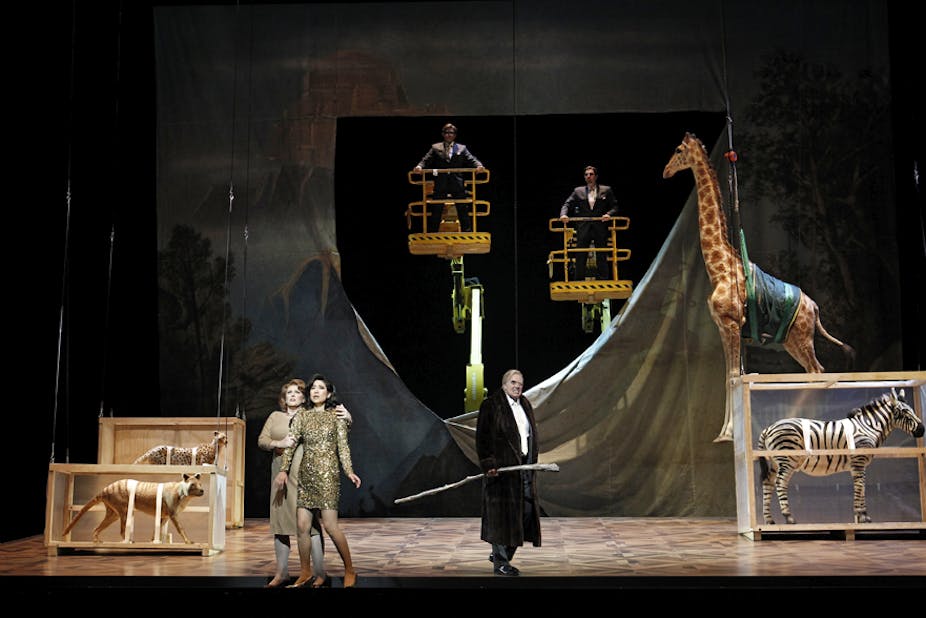It should come as no surprise in the nation that gave the world the Big Pineapple, the Big Guitar, the Big Sheep, and, for that matter, a Big Ad, that the size of a cultural artefact in and of itself is enough to impress us.
Build something large enough, or do something often enough, and it stakes a claim on our attention. No immediate surprise, then, that Richard Wagner’s Der Ring des Nibelungen also fascinates Australians, including many who might not otherwise give opera a second thought.
Extending over four nights, it consists of almost 16 hours of music written for immensely powerful voices singing over a colossal pit orchestra, and took about 26 years (from 1848 to 1874) to complete. If that is not a big enough list of “bigs”, the budget required to stage it is also of such a size that it can cripple even the most well-endowed opera company.
In the case of The Ring, however, size is most definitely not everything; there is more to our interest than that.

Wagner’s professed aim, in fact, was not to be grandiose per se, but to equal what he considered to have been the highest achievement of human creativity – Greek tragedy. The Greeks, he believed, had developed a kind of communal art-as-therapy where the polis came together to celebrate and reflect upon what had sustained and nurtured them both as individuals and as a community.
Moreover, their theatre had also involved a successful combination of all the arts: poetry, drama, costume, dance, music, song.
Subsequently, however, this Greek drama had disintegrated, if not degenerated, into its various components, so that by Wagner’s time (1813–1883) we had been left, as he saw it, with instrumental music without words, theatre without poetry, poetry without music, and so on.

This was no mere historical observation but was instead, he believed, a sign of a larger societal decay. For him, opera in particular had become little more than entertainment for the weary professional classes, a frivolous and vulgar manifestation of a world becoming inexorably estranged from itself.
His critique, which helps explain much of the plot of The Ring, preempts much of Karl Marx’s theory of alienation (Entfremdung), which similarly asserted that we were becoming estranged from the products of our labour and from each other.
So that is what the fuss is about. But what is The Ring itself about?
Well, the convoluted plot is principally derived from a collection German mythical stories called the Nibelungenlied, a sort of Northern European version of the Iliad.
Like its Greek counterpart, it involves gods and mortals incestuously interacting with one another in the manner of one colossal dysfunctional family and, taken out of context, the tale appears (like many opera plots before and since) to border on the ridiculous.
So too, however, do many of our classic myths, so we should not be concerned by this fact. The Ring is not meant to be realist drama, but rather a drama-as-allegory.
Its real dramatic content is not so much “out there” on stage as something found within in the minds of the characters, and in what is implied, what is alluded to, by their actions. Going to The Ring, then, is more like witnessing a collective dream, and like all dreams it demands, and rewards, interpretation (it is not for nothing that Wagner’s music dramas are also particular beloved by psychoanalysts).
Our portal into this inner world of The Ring, and also what ultimately makes it so compelling, is Wagner’s music. By doing away with the conventional structural forms of opera and composing instead a texture that he described as “endless melody”, Wagner was able to create a complex and profoundly interconnected set of “leitmotifs” (sonic calling cards, if you like) that enable the orchestra not merely to reflect what is going on the stage action, but to become intimately fused with it, and indeed analyse it.
In effect The Ring ends up becoming one vast symphonic drama, with the orchestra as its most important character.
The broad details of the plot will be already familiar to those who have read (or seen) The Lord of the Rings Trilogy by J. R. R. Tolkien. Both works involve giants and dwarfs and such-like, and concern rings that corrupt the wearer while giving him or her mastery over the world.
Both, indeed, are also implied critiques of industrialised capitalist society. For those wanting to know more of the plot in finer detail, a great place to start is with two clever on-line resources; a two-and-a-half minute (yes, almost 400 times shorter than the actual Ring) plot summary (see video above) recently prepared by the Sydney Symphony Orchestra, and the justly famous comic (but ultimately reverential) analysis by the English-Canadian singer and comedienne Anna Russell, below:
Performances of the sold-out Melbourne Ring Cycle take place until December 13, 2013.
Further reading: Should we fund Wagner operas or statues of Kyle Sandilands?

